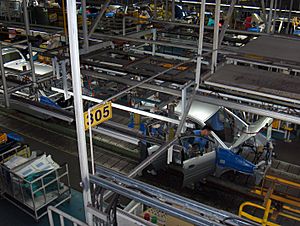Mass production facts for kids
Imagine making thousands of the exact same toy, car, or phone. When an item is made in very large numbers, it's called mass production. This usually happens in a factory, and all the items look and work the same.
Mass production relies on two big ideas:
- Standardized products: This means every part of the product is made to be exactly the same. Think of a LEGO brick – any two of the same type will fit together perfectly.
- Interchangeable parts: This means that if one part breaks, you can easily replace it with another identical part. You don't need a special, custom-made replacement. This makes repairs much easier and faster.
Today, machines do a lot of the work in mass production. This helps make things faster and more accurate.
Contents
How Mass Production Works
The Assembly Line
One of the most famous ways to mass produce items is using an assembly line. On an assembly line, a product moves from one workstation to the next. At each stop, a different worker or machine adds a specific part or performs a specific task. This way, many people work together to build one item, but each person only does a small part of the job.
Division of Labor
The idea of breaking down a big job into smaller, simpler tasks is called division of labor. This makes production much faster. For example, instead of one person building an entire car, one person might only put on the wheels, another installs the engine, and so on.
The famous thinker Adam Smith talked about this idea a long time ago. He used the example of making a needle. He showed that if different people focused on different steps of making a needle, they could produce many more needles together than if each person tried to make a whole needle by themselves.
Later, Frederick Winslow Taylor also used the idea of division of labor. He wanted to make factories even more efficient. He suggested dividing tasks into "planning" (thinking about how to do the work) and "execution" (actually doing the work). This approach is sometimes called Taylorism.
History of Mass Production
Mass production isn't a brand new idea. People have been making many similar items for a long time.
- Even in the Bronze Age, people used molds to cast several identical tools at once.
- In the 1500s, printers used special presses to make many copies of books. Each printer had a specific job, like inking the blocks or removing pages.
- By the early 1800s, factories were making thousands of identical parts, like pulley blocks for ships, using machines.
Henry Ford and the Modern Assembly Line
One of the most important steps in mass production came with Henry Ford in the early 1900s. He took the idea of the assembly line and made it even better. In 1913, Ford introduced the moving assembly line for making cars. Instead of workers moving to the car, the car moved to the workers. This made building cars incredibly fast and much cheaper. Because of this, more people could afford to buy cars.
Benefits and Impact
Mass production has changed the world in many ways:
- Lower Costs: Because so many items are made, the cost to make each one goes down. This means products become more affordable for everyone.
- More Products: Factories can produce huge numbers of goods very quickly, meeting the demands of many people.
- Consistent Quality: Machines and standardized processes help ensure that every product is of similar quality.
However, mass production also has impacts. The work can sometimes be repetitive for people on the assembly line. Also, making so many products uses a lot of resources and can affect the environment.
Images for kids
-
Sometimes production in series has obvious benefits, as is the case with this 5-sickle casting mold from the Bronze Age on show at a museum in Yekaterinburg, Russia.
-
This woodcut from 1568 shows the left printer removing a page from the press while the one at right inks the text-blocks. Such a duo could reach 14,000 hand movements per working day, printing around 3,600 pages in the process.
See also
 In Spanish: Producción en cadena para niños
In Spanish: Producción en cadena para niños








